Thanks to my mold fiasco and resulting health issues, I hadn’t had sourdough bread (or any bread for that matter) in years. I really can’t remember exactly how long it had been. Maybe 5 years?
Sure, I made coconut flour based breads but they had so many eggs that they never were able to reach that “sandwich bread” consistently I sometimes missed. They certainly never came close to sourdough bread.
In 2015 I met my dear friend Andrea from It Takes Time and she whipped up a batch of gluten free sourdough bread that was totally out of this world! She literally made it in minutes and we were gobbling up the deliciousness within an hour.
Of course I had to have the recipe. Andrea shared this one with me and I couldn’t wait to get home and make it myself!
While I loved Andrea’s sourdough bread recipe, my daughter and I cannot have nuts. (Don’t worry – Andrea didn’t use any nut flours while we were there). I wanted to play around a little with some of our favorite flours to see what might happen with various blends. I actually came up with a couple of variations, both of which I liked quite a bit.
Gluten Free, Grain Free Sourdough Bread With A Twist
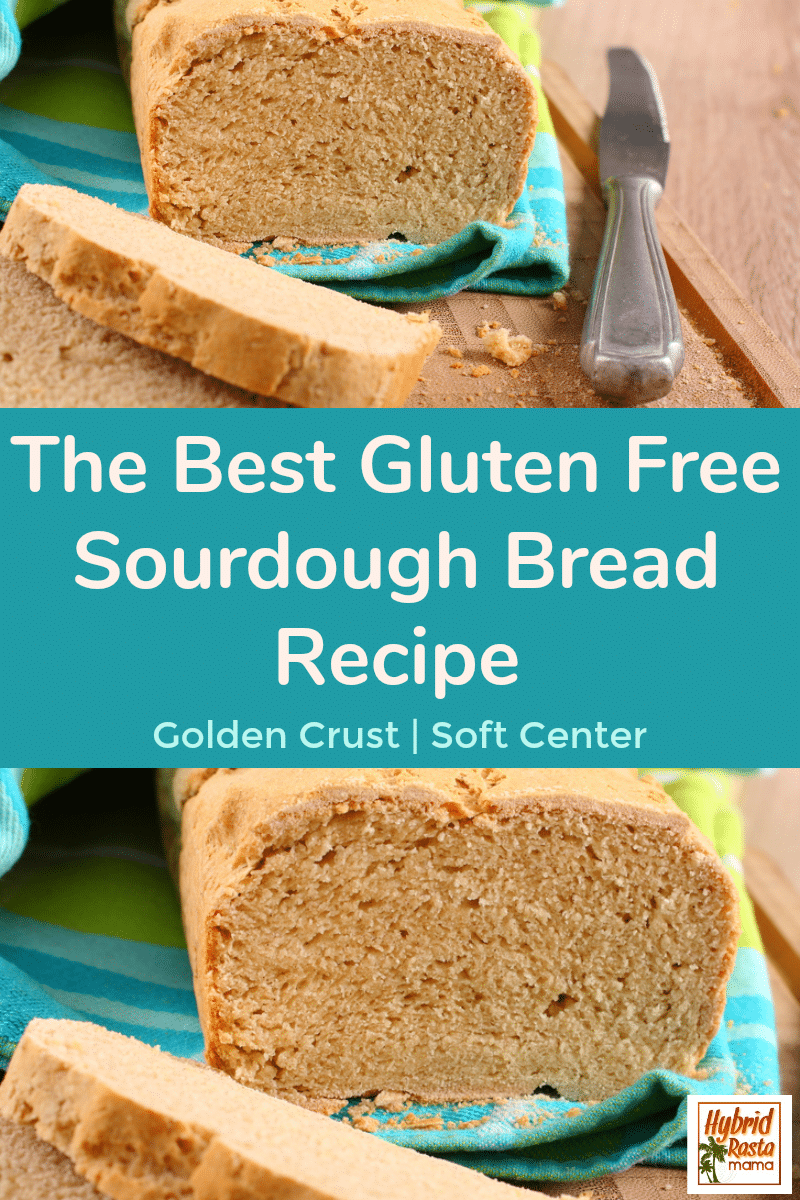
Today, I am sharing my spin on Andrea’s original recipe. I think you all will enjoy trying one or both of these out, especially if you haven’t had sourdough in a while. And no – it doesn’t taste exactly like the real thing. But it comes pretty close!
In order to make this delicious gluten free sourdough bread you are going to want to start with my gluten free, grain free sourdough starter.
Be sure to check out my delicious pumpkin sourdough bread recipe as well.
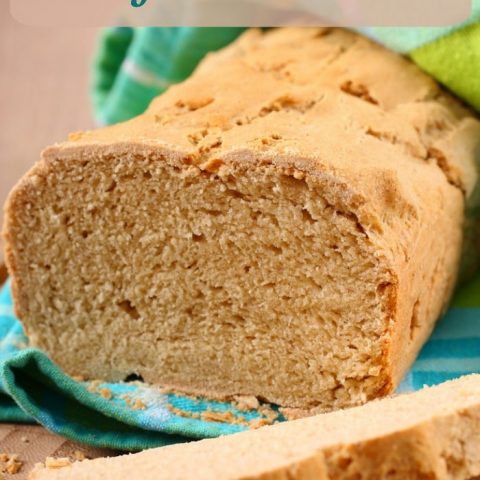
Gluten Free, Grain Free Sourdough Bread With A Twist
This Gluten Free, Grain Free Sourdough Bread With A Twist is perfect for sourdough lovers with food allergies. Soft middle, crunchy crust...sourdough dream.
Ingredients
Sourdough Bread #1
- 3 cups gluten free sourdough starter
- 1 ½ cups tigernut flour
- 1 cup quinoa flour
- 1/2 cup cassava flour
- 1 tablespoon sea salt
- 1/2 cup filtered water
Sourdough Bread #2
- 3 cups sourdough starter
- 1 cup tigernut flour
- 1 cup quinoa flour
- 1 cup potato flour
- 1 tablespoon sea salt
- 1/2 cup filtered water
Instructions
- Blend all of the ingredients together. I was able to do this by hand but a handheld or stand mixer would have been a lot easier.
- Pour the batter into two loaf pans. Andrea allows her bread to rise. I skipped this step.
- Cover the loaf pans (or place in a dutch oven) and pop into the oven. Turn it to 375 degrees.
- Bake for 30 minutes.
- Crank the heat to 400 degrees and allow to bake another 20 minutes.
- After 20 minutes, check the loafs with a toothpick. If they come out fairy clean, remove the cover from the loaf pans and bake an additional 10-12 minutes to brown the top. If the center is still moist, keep baking covered, checking every 5 minutes. Once cooked in the middle, remove the covers and bake until the tops are browned.
- Cool and serve. I like to bake these the night before and serve the next day. The texture is a lot better if you allow the loaf to rest.
Notes
- We did try using rice flour in one variation and it worked well. My daughter can tolerate white rice and likes the option of rice flour. Use it in place of the cassava flour.
- You can also throw in ¼ cup of chia seeds if you would like. It was pretty tasty like that.
- To make an extra savory bread, mix in ¼ cup of Italian herbs.
Recommended Products
Nutrition Information:
Yield: 8 slices Serving Size: 1 sliceAmount Per Serving: Calories: 0Total Fat: 0gSaturated Fat: 0gTrans Fat: 0gUnsaturated Fat: 0gCholesterol: 0mgSodium: 1mgCarbohydrates: 0gFiber: 0gSugar: 0gProtein: 0g
This website provides approximate nutrition information for convenience and as a courtesy only. Nutrition data is gathered from Nutritionix. Nutrition information can vary for a recipe based on many factors. We strive to keep the information as accurate as possible, but make no warranties regarding its accuracy. We encourage readers to make their own calculations based on the actual ingredients used in your recipe, using your preferred nutrition calculator.

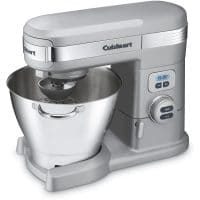
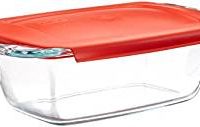
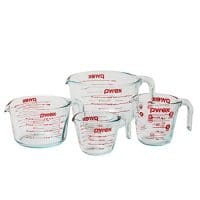

Andrea Fabry says
I love your spin on the recipe, Jennifer! It was so great seeing you that day. Anytime I make this without tigernut flour it lacks a little in flavor. I love that flour!
Anne says
I am happy to find this post! I spent over a year making gluten free sourdough bread, but have come to the conclusion even gluten free grains are a problem for me. I have been doing much better grain free and have been looking and thinking on what I might use to try a grain free sourdough. Previously, I only found a very science-y blog stating problems/issues with cassava as a starter. I was wondering if tigernut flour would work, and am encouraged by your post! Thanks for taking the time to post your recipes!
Jennifer says
Hi Anne! I am so happy this helped. I love this bread so darn much! I hope it works well for you.
Tara says
I think I could do recipe #1 except for the quinoa. Is there anything I could sub for it? Would more cassava work in place of the quinoa?
Jennifer says
I gave this a try with the substitution of cassava flour. It worked but it made the bread a little doughy.
Cristina says
Would I be able to substitute the cassava flour with more tiger nut or quinoa flour?
Jennifer says
Absolutely! It will change the texture a bit as cassava flour gives the bread it’s “chewyness.”
Theresa says
Hi what would be the weight measurement for the flours? I found with cup measurements threw out the consistency especially with cassava flour.
Looking forward to giving this a whirl and finally giving my son a good quality GF sourdough:)
Jennifer says
Hi Theresa! Next time I make this I will figure out the weight measurements for you. I linked to the actual flours I use in the ingredient list and these will be the ones I will use. Brand shouldn’t matter too much though. I would think the weights would be about the same. I will shoot you an email here in the next week or so.
Karen says
Hi,
If I wanna do only one loaf, Do you know if it will work by using half measurements?
Jennifer says
Yep! Should work just fine. 🙂
Ana says
Hi! Can’t wait to try this! Is there anything I can substitute for quinoa flour though? Also, does the Anthony’s brand of tigernut flour work as a starter too?
Jennifer says
Anthony’s Tigernut Flour is great stuff! It should work just fine. As for the quinoa… that particular flour is what gives this bread that “sour” edge. Some people have replaced with it rice flour but of course that doesn’t make it grain free anymore. They also report that the bread was a little but sticker without the quinoa. I have used garbanzo flour before. Flax meal is a good choice as well. I hope this helps!
Kelsey says
Quinoa is a grain. This recipe is not exclusively grain free, I’m afraid.
Jennifer says
Oh no! I had someone updating all my recipes and this clearly was a mistake. Thank you for letting me know!
Chelsea says
Thank you so much for the recipe! I’m giving it a try today 🙂 Quick question; when you say “cover the loaf pans” are you using foil to cover them?
Jennifer says
Yes! Cover with foil or parchment paper then foil. 🙂
Mairi Winstanley says
Hi, could this recipe be used to make buns? Thanks 🙂
Jennifer says
Hi Mairi! I had to give that some thought. I once tried to make a baguette loaf out of this. It sort of worked. 😉 I think buns would have more success because they are smaller. You will want to watch the bake time VERY closely though because I could see these getting really crispy on the outside but not quite cooked on the inside. Perhaps cook at 350 degrees and then crank the heat up at the end to crisp the top if needed. If you try it, please let me know if it works!
Hannah says
Hi there! Do you think this would work with 1:1:1 Cassava, tigernut, and almond flour? or maybe Cassava, tigernut, flax?
Jennifer says
Just saw this! Looks like you already started your starter but yes, that should work fine.